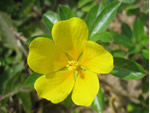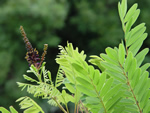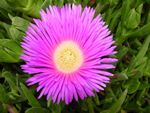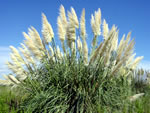
EPPO Lists of Invasive Alien Plants
EPPO, in the framework of the International Plant Protection Convention (IPPC) and the Convention on Biological Diversity (CBD), has developed a programme to protect the EPPO region against invasive alien plants. In 2002 the EPPO Panel on Invasive Alien Plants was created and was given the task to identify invasive alien plant species which may present a risk to the EPPO region, and to provide information and where appropriate to propose management options.
The number of plants that can be considered as potential pest species is very large and the Panel has elaborated a process for all known, or potential invasive alien plants in the EPPO region to assess the risk and prioritise candidates for PRA. During this process, the Panel is documenting invasive alien plant species on data sheets and when necessary, conducting Pest Risk Analyses (PRAs) following the EPPO Decision-support scheme, 'Pest Risk Analysis for quarantine pests'. As a result of these studies, the following lists of invasive alien plants have been established.
Read a detailed evaluation on the EPPO Prioritization Process and how species are added or removed from the lists.




EPPO A1/A2 Lists of pests recommended for regulation as quarantine pests
One of EPPO’s main missions is to help its member countries in preventing the introduction of pests from other parts of the world, and to limit their spread within the region should they be introduced. It is therefore necessary to develop at a regional level, common strategies to identify, evaluate and mitigate these risks by proposing phytosanitary measures whenever appropriate. These EPPO recommendations can then serve as a basis for NPPOs when establishing their phytosanitary regulations.
Invasive alien plants which have been added to the EPPO A1/A2 Lists of pests recommended for regulation as quarantine pests are listed in the table below. The purpose of the EPPO A1/A2 Lists is to recommend that organisms of serious phytosanitary concern should be regulated as quarantine pests by EPPO member countries (A1 pests are absent from the EPPO region and A2 pests are locally present in the EPPO region). Plant species, before being submitted to a PRA, have been identified through the EPPO Prioritization Process as presenting a high risk, have been identified on international pathways of introduction and have a significant suitable area for further spread in the EPPO region. The listing of pests is based on technical justifications (i.e. PRAs) and follows a meticulous approval procedure in several steps reviewed by the Panel and the member countries, and approved by the Working Party on Phytosanitary Regulations and finally adopted by the EPPO Council.
|
Plant name (link to EPPO Global Database to retrieve PRA documents and datasheets)
|
EPPO A1/A2 Lists |
| Ageratina adenophora | A2 in 2023 |
| Alternanthera philoxeroides |
A2 in 2015
|
| Amaranthus palmeri | A2 in 2020 |
| Amaranthus tuberculatus | A2 in 2020 |
| Ambrosia confertiflora [evaluated under EU LIFE project] | A2 in 2018 |
| Ambrosia trifida | A2 in 2019 |
| Andropogon virginicus [evaluated under EU LIFE project] | A2 in 2018 |
| Baccharis halimifolia |
A2 in 2013
|
| Cardiospermum grandiflorum [evaluated under EU LIFE project] |
A2 in 2017
|
| Celastrus orbiculatus | A2 in 2021 |
| Cortaderia jubata [evaluated under EU LIFE project] | A1 in 2018 |
| Crassula helmsii |
A2 in 2006
|
| Ehrharta calycina [evaluated under EU LIFE project] | A2 in 2018 |
| Eichhornia crassipes |
A2 in 2008
|
| Euphorbia davidii | A2 in 2025 |
| Gymnocoronis spilanthoides [evaluated under EU LIFE project] |
A2 in 2017
|
| Hakea decurrens subsp. physocarpa | A2 in 2024 |
| Hakea sericea [evaluated under EU LIFE project] | A2 in 2018 |
| Heracleum persicum |
A2 in 2009
|
| Heracleum sosnowskyi |
A2 in 2009
|
| Humulus scandens [evaluated under EU LIFE project] | A2 in 2018 |
| Hydrocotyle ranunculoides |
A2 in 2005
|
| Lespedeza cuneata [evaluated under EU LIFE project] | A1 in 2018 |
| Ludwigia grandiflora |
A2 in 2011
|
|
A2 in 2011
|
|
| Lygodium japonicum [evaluated under EU LIFE project] | A1 in 2018 |
| Microstegium vimineum |
A2 in 2015
|
| Myriophyllum heterophyllum |
A2 in 2015
|
| Neltuma juliflora (=Prosopis juliflora) [evaluated under EU LIFE project] | A2 in 2018 |
| Parthenium hysterophorus |
A2 in 2014
|
| Persicaria perfoliata | A2 in 2008 |
| Pistia stratiotes [evaluated under EU LIFE project] |
A2 in 2017
|
| Pueraria montana var. lobata |
A2 in 2006
|
| Salvinia molesta [evaluated under EU LIFE project] |
A2 in 2017
|
| Solanum carolinense | A2 in 2022 |
| Solanum elaeagnifolium |
A2 in 2006
|
| Triadica sebifera [evaluated under EU LIFE project] | A1 in 2018 |
| Zizania latifolia | A2 in 2024 |
EPPO List of invasive alien plants
The plants listed below have been identified by the Panel as being absent or present in the EPPO region; as having a high potential for spread; as posing an important threat to plant health and/or the environment and biodiversity; and eventually as having other detrimental social impacts on health, agriculture, horticulture and forestry, infrastructure, on recreational activities, or other trade related impacts such as market losses etc., in the EPPO region. Species in this list may be absent or present in the EPPO region. Because a large number of invasive alien plants are already present in the EPPO region, priorities were set in order to select those species considered to pose the greatest threat to species and ecosystems in the EPPO region. EPPO therefore recommends countries endangered by these species to consider taking measures to prevent their introduction and spread, or to manage unwanted populations (for example with awareness raising, restrictions on sale and planting, and control measures). This List is constantly being reviewed by the Panel (new species can be added and others removed). The List is not meant to be exhaustive but to focus on the main risks. All species of the A1/A2 List fulfil the criteria to be listed on the List of invasive alien plant but are of special concern to EPPO because of their limited distribution within the EPPO region and international pathways of introduction.
EPPO Observation List of invasive alien plants
The EPPO Observation List contains plant species (absent or present in the EPPO region) which through the Prioritization Process are assessed as presenting a medium risk (which is defined as low to medium spread potential combined with high impact or medium to high spread potential combined with medium impact) and species for which not enough information is available to make an accurate assessment. The EPPO Observation List was created in 2012 and it is constantly being reviewed by the Panel on Invasive Alien Species (new species can be added and others removed). The list is not meant to be exhaustive but to focus on species that present a medium risk.
EPPO Alert List (extract)
The main purpose of the Alert List is to draw the attention of NPPOs to emerging pests, diseases and invasive alien plants possibly presenting a risk to the EPPO region and achieve early warning. It can also be used by EPPO to select candidates which may be submitted to a Pest Risk Analysis (PRA). Species included in the Alert List have been selected by the EPPO Secretariat or proposed by EPPO member countries, because they may present a risk to the EPPO region. A species is maintained on the EPPO Alert List for a period of time (up to three years). Most species are still of limited distribution, or absent from the EPPO region. Each addition to the EPPO Alert List is also marked by a short article in the EPPO Reporting Service. Following a period of time, invasive alien plants recorded in the Alert List are assessed through the EPPO Prioritization process to determine whether they should be included in the List of Invasive Alien Plants, the Observation List, the list of minor concern, or a PRA should be conducted for listing on A1/A2 lists.
Read a short introduction to the EPPO Alert List.
Invasive alien plants included in the EPPO Alert List – for pests other than invasive alien plants view the full Alert List ![]()
|
Plant name
|
Added in | Mini data sheets | Link to EPPO Global Database |
| Acalypha australis | 2025 | Alert List | Link |
| Ageratina altissima | 2025 | Alert List | Link |
| Ambrosia grayi | 2024 | Alert List | Link |
| Aponogeton distachyos | 2024 | Alert List | Link |
| Hakea salicifolia | 2024 | Alert List | Link |
|
Houttuynia cordata |
2022 | Alert List | Link |
| Lonicera acuminata | 2019 | Alert List | Link |
| Myriophyllum rubricaule | 2024 | Alert List | Link |
| Paulownia tomentosa | 2021 | Alert List | Link |
| Phyllostachys aurea | 2025 | Alert List | Link |
| Pontederia cordata | 2022 | Alert List | Link |
| Pseudosasa japonica | 2020 | Alert List | Link |
| Sasa palmata | 2025 | Alert List | Link |
| Saururus cernuus | 2023 | Alert List | Link |
| Senecio brasiliensis | 2023 | Alert List | Link |
| Sporobolus cryptandrus | 2022 | Alert List | Link |
| Sporobolus neglectus | 2022 | Alert List | Link |
| Sporobolus vaginiflorus | 2022 | Alert List | Link |
| Vallisneria australis | 2023 | Alert List | Link |
